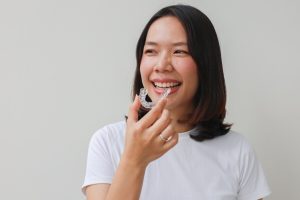If you are missing teeth, you may have difficulty chewing or speaking, and you may be self-conscious about your smile. If you are considering an option to replace your teeth, partial dentures might be the solution you are looking for. Partial dentures replace one or more missing teeth while still appearing natural with your existing teeth. Whether you decide on a removable or fixed solution, knowing the types of partial dentures available and the advantages and disadvantages of each will help you decide the best option for you.
If you are considering partial dentures in Calgary SE, it is a good idea to find out what your options are so that you can find the right fit for your lifestyle, comfort and budget. You will likely find that a professional consultation with a dentist in Calgary will help weed out which options are right for you, but here is a quick starting guide.
What are Partial Dentures?
Partial dentures are dental appliances designed to replace missing teeth when some natural teeth remain. Full dentures are made to cover a complete arch. Partials replace only those gaps that need to be filled. In addition to appearance, partial dentures also serve a useful purpose in preserving an appropriate bite relationship and preventing the teeth on either side of the gap from drifting to compensate for the missing teeth.
Different Types of Partial Dentures
There are different types of partial dentures today. Each type is designed, made out of different materials, and has a different level of stability.
Acrylic Partial Dentures
- Made from a gum-colored acrylic material with artificial teeth.
- These are often used as a temporary solution or as the most affordable type.
- They are less durable than other types, but they are lightweight.
Cast Metal Partial Dentures
- Made using a thin, strong metal framework.
- These are well known for durability and stability, and will compress onto existing teeth.
- Less bulky than acrylic partials.
Flexible Partial Dentures
- These are made out of a soft, flexible thermoplastic material.
- These can feel more natural and are more comfortable since they do not have visible metal clips.
- They can be easy to adapt to, particularly for patients who are new to dentures.
- They could last less long than a metal option.
Fixed Partial Denture (Dental Bridge)
- They are cemented or bonded into place rather than removable.
- Provide a strong natural feel since they do not move.
- Rely on either adjacent natural teeth or dental implants as a support.
- It is a good long-term solution but is usually the most expensive option.
Removable vs Fixed Partial Dentures
In comparison of removable vs fixed partial dentures, they include:
- Removable Partial Dentures
- Easy to clean and maintain.
- May be removed at night or even during cleaning.
- More affordable upfront.
- May needs modifications with time so as to feel comfortable.
- Fixed Partial Dentures
- Perform and have a feel that are more natural.
- No need to remove it daily.
- Stability is increased and it might need to change neighbouring teeth.
- Expensive over and above removable.
Best Partial Denture Options
The selection of the best partial denture options is determined by needs, finances, and the health of your mouth
For example:
- Acrylic dentures may be an option in case affordability is your issue.
- Flexible dentures may be the appropriate option in case comfort and appearance are highly important.
- In order to be stable in the long term, it is usually advisable to use cast metal or fixed dentures.
Before making a decision, a visit to a dental clinic near you will allow your individual case to be assessed accordingly.
Partial Dentures Pros and Cons
Partials, just like any dental solution, have their merits and demerits.
Pros
- Rehabilitate functionality and looks.
- Eliminate natural tooth movement.
- Affordable implants.
- Designs that can be used for a variety of needs.
Cons
- May require time to adjust.
- Removable types may become less stable.
- It should be cleaned and maintained.
- May must be replaced or changed with time.
How to Choose Partial Dentures
The following are some of the tips on how to choose partial dentures that will suit you best:
- Talk to your dentist about your aspirations and way of life.
- Take into account operating and fixed costs.
- Inquire about the longevity, comfort, and appearance of the types.
- Determine the pros of removable and fixed.
- You should not be afraid to request your dentist near you in Calgary to provide you with examples.
Conclusion
Partial dentures may be life-altering, as they restore functionality and self-esteem. The correct decision is one that is based on your individual needs, dentinal health, as well as your comfort. Get professional advice to discuss your dentures and receive expert help depending on your smile. Book a consultation at Inglewood Family Dental in Calgary today.







